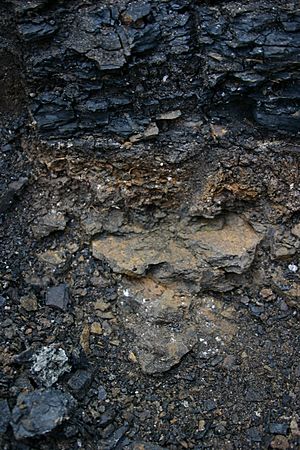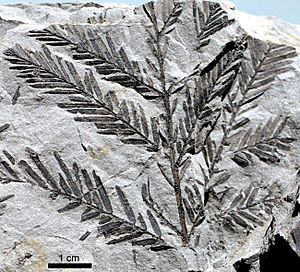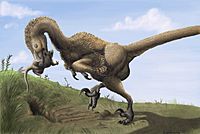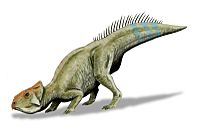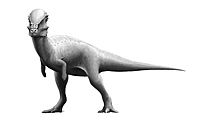Scollard Formation facts for kids
The Scollard Formation is a special set of rock layers found in southwestern Alberta, Canada. These rocks were formed during a very long time, from the end of the Cretaceous Period to the beginning of the Paleocene Epoch. This means they hold clues about a huge event in Earth's history: the Cretaceous-Paleogene (K-Pg) extinction event, which is when the dinosaurs disappeared! The Scollard Formation is famous for its amazing fossils and also for its important coal deposits, especially in an area called the Ardley coal zone.
Quick facts for kids Scollard FormationStratigraphic range: Maastrichtian-Danian ~70–65Ma |
|
|---|---|
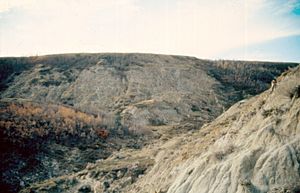
Scollard Formation exposed along the Red Deer River, Alberta. The Tyrannosaurus rex skeleton on display at the Royal Tyrrell Museum of Palaeontology of Palaeontology was excavated in the center of image.
|
|
| Type | Geological formation |
| Unit of | Edmonton Group |
| Sub-units | Ardley coal zone |
| Underlies | Paskapoo Formation |
| Overlies | Battle Formation |
| Thickness | Up to 300 metres (980 ft) |
| Lithology | |
| Primary | Sandstone, siltstone, shale |
| Other | Coal, bentonite |
| Location | |
| Coordinates | 51°56′19″N 112°55′37″W / 51.93861°N 112.92694°W |
| Approximate paleocoordinates | 62°48′N 86°12′W / 62.8°N 86.2°W |
| Region | |
| Country | |
| Extent | Western Canada Sedimentary Basin |
| Type section | |
| Named for | Scollard Canyon at Dry Island Buffalo Jump Provincial Park |
| Named by | Irish, E.J.W |
| Year defined | 1970 |
Contents
What Are Scollard Rocks Made Of?
The Scollard Formation is mostly made of sandstone and siltstone. You can also find layers of mudstone and, higher up, thick layers of coal. There's even a small amount of a special clay called bentonite.
These rocks were formed from bits of rock and dirt that washed down from the Canadian Rocky Mountains. Ancient rivers carried these materials eastward, dropping them off in river channels and on wide floodplains, which are flat areas next to rivers that sometimes flood.
How Old Are the Scollard Rocks?
The Scollard Formation is divided into two main parts. The lower part formed during the very end of the Maastrichtian Age, which was the last part of the Cretaceous Period. This is when dinosaurs were still roaming the Earth.
The upper part of the Scollard Formation, which contains the Ardley coal zone, is from the early Danian Age. This is the first part of the Paleocene Epoch, right after the dinosaurs went extinct.
The K-Pg Boundary
The line between the Cretaceous and Paleocene periods is called the K-Pg boundary. In the Scollard Formation, this important boundary is found at the bottom of the lowest coal layer in the Ardley coal zone. Scientists know this because they've found clues like dinosaur fossils below this line and different plant fossils above it. They've also found a special layer of iridium, a rare metal, which is a sign of the asteroid impact that caused the K-Pg extinction.
Where Can You Find the Scollard Formation?
You can find the Scollard Formation deep underground across much of southwestern Alberta. It also pops out of the ground along the banks of the Red Deer River near Trochu.
The rock layers are thicker in the west, closer to the Canadian Rockies, where they can be over 300 metres (980 ft) thick. As you go east, they get thinner, sometimes less than 100 metres (330 ft) thick.
What About Coal in the Scollard Formation?
The Ardley coal zone in the Scollard Formation has very thick layers of coal, some more than 7 metres (20 ft) thick! This coal is found close to the surface in an area between Red Deer and Edmonton.
This coal is used to power electric generating stations. It's dug up from mines and then burned to make electricity.
What Fossils Are Found in the Scollard Formation?
The Scollard Formation is a treasure chest of fossils! It has remains of animals, especially dinosaurs and, less often, early mammals. It also has many different kinds of plant fossils.
Because the Scollard Formation covers the K-Pg boundary, the lower layers show us what life was like for the last dinosaurs. The upper layers, however, show us the beginning of the "Age of Mammals" after the big extinction event.
Ancient Plants
In the upper, early Paleocene part of the Scollard Formation, scientists have found fossils of many plants. These include different types of ferns, conifers like Metasequoia (a type of redwood), and flowering plants like Platanus (similar to modern sycamore trees).
Dinosaur Discoveries
The Scollard Formation is famous for its dinosaur fossils. Here are some of the dinosaurs found in these rocks:
Meat-Eating Dinosaurs (Theropods)
| Theropods | ||||||
|---|---|---|---|---|---|---|
| Genus | Species | Location | Stratigraphic position | Material | Description | Images |
|
cf. Dromaeosaurus |
Indeterminate |
Teeth |
||||
|
cf. Paronychodon |
Indeterminate |
|||||
|
cf. Richardoestesia |
cf. R. gilmorei |
|||||
|
cf. R. isosceles |
||||||
|
cf. Saurornitholestes |
cf. S. langstoni |
|||||
|
Indeterminate |
||||||
|
T. rex |
||||||
Plant-Eating Dinosaurs (Ornithischians)
Color key
|
Notes Uncertain or tentative taxa are in small text; |
| Ornithischians | ||||||
|---|---|---|---|---|---|---|
| Genus | Species | Location | Stratigraphic position | Material | Description | Images |
|
A magniventris |
||||||
|
E. annectens |
||||||
|
L. gracilis |
||||||
|
Indeterminate |
||||||
|
T. edmontonensis |
Referred to Thescelosaurus sp. |
|||||
|
T. prorsus |
||||||
Images for kids
-
Ankylosaurus skull


